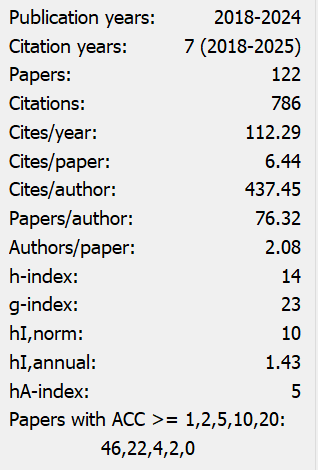Impact of the Corona Pandemic on Household Welfare in Cameroon
Abstract
The objective of this study was to examine the effect of the Corona Virus Disease (COVID-19) on household welfare in Cameroon. This was done using data from a survey of 264 households in Cameroon in 2020. A linear regression model and Heckman sample correction bias were used and the results showed that COVID-19 reduces household welfare in Cameroon. These findings have implications of reducing the impact of COVID-19 on household welfare if households should develop new sources of income and food strategies by engaging more on agricultural activities and government can take a strategy of allocating grants either by reducing the cost of necessities (water, electricity, foodstuff, and housing). The triple helix approach where government, institutions of technology, and businesses should develop a vaccine for the pandemic to bring back economic life to normal.
References
Atkeson, A. (2020). What will be the Economic Impact of COVID-19 in the US? Rough Estimates of Disease Scenarios, National Bureau of Economic Research (NBER) Working Paper 26867, 1050 Massachusetts Avenue Cambridge. https://doi.org/10.3386/w26867
Baldwin, R., & Weder, B. D. M. (2020). Economics in the Time of COVID-19, Centre for Economic Policy Research-CEPR Press ISBN: 978-1-912179-28-2, 33 Great Sutton Street London.
Bell, C., Devarajan, S., & Hersbach, H. (2004). Thinking about the long-run economic costs of AIDS, in The Macroeconomics of HIV/AIDS, M. Haacker (eds). Washington DC., IMF: 96-144.
Bhargava, A., et al. (2001). Modeling the Effects of Health on Economic Growth. Journal of Health Economics 20(3), 423-440. https://doi.org/10.1016/S0167-6296(01)00073-X
Bloom, D. E., & Sachs, J. D. (1998). Geography, Demography, and Economic Growth in Africa. Brookings Papers on Economic Activity, (2), 207-273.
Bloom, E., V. D. W., et al. (2005). Potential economic impact of an Avian Flu pandemic on Asia. ERD Policy Brief Series No. 42, Asian Development Bank, Manila. Retrieved from http://www.adb.org/Documents/EDRC/Policy_Briefs/PB042.pdf
Congressional Budget Office (CBO, 2005). A Potential Influenza Pandemic: Possible Macroeconomic Effects and Policy Issues, CBO Washington DC.
Cuddington, J. T., & Hancock, J. D. (1994). Assessing the Impact of AIDS on the Growth Path of the Malawian Economy. Journal of Development Economics, 43(2), 363-368. https://doi.org/10.1016/0304-3878(94)90013-2
Cuddington, J. T., & Hancock, J. D., et al. (1994). A Dynamic Aggregate Model of the AIDS Epidemic with Possible Policy Interventions. Journal of Policy Modeling, 16(5), 473-496. https://doi.org/10.1016/0161-8938(94)90024-8
Haacker, M., Ed. (2004). The Macroeconomics of HIV/AIDS. IMF, Washington DC.
Heckman, J. (1979). Sample selection bias as a specification error. Econometrica, 47(1), 153-162. https://doi.org/10.2307/1912352
International Labor Organization (ILO, 2020). COVID-19 and the world of work: Impact and policy responses. Retrieved from http://ilo.org/global/topics/coronavirus
McKibbin, W., & Sidorenko, A. (2006). “Global Macroeconomic Consequences of Pandemic Influenza” Lowy Institute Analysis, February, 100 pages.
McKibbin, W., & Sidorenko, A. (2009). “What a Flu Pandemic Could Cost the World", Foreign Policy, April. Retrieved from https://foreignpolicy.com/2009/04/28/what-a-flu-pandemic-could-cost-the-world/
McKibbin, W., & Fernando, R. (2020). The Global Macroeconomic Impacts of COVID-19: Seven Scenarios, Centre for Applied Macroeconomic Analysis (CAMA) of the Australian National University Working Paper 19/2020 February 2020. https://doi.org/10.1162/asep_a_00796
Meltzer, M. I., & Cox, N. J., et al. (1999). The economic impact of pandemic influenza in the United States: priorities for intervention. Emerging Infectious Diseases, 5(5), 659-671. https://doi.org/10.3201/eid0505.990507
OECD. (2020). OECD Economic Outlook, Interim Report March 2020, OECD Publishing. Retrieved from http://www.oecd.org/newsroom/global-economy-faces-gravest-threat-since-the-crisis-as-coronavirus-spreads.htm
Robalino, D. A., & Voetberg, A., et al. (2002b). The Macroeconomic Impacts of AIDS in Kenya Estimating Optimal Reduction Targets for the HIV/AIDS Incidence Rate. Journal of Policy Modeling, 24(2), 195-218. https://doi.org/10.1016/S0161-8938(02)00097-2
Robalino, D. A., & Jenkins, C., et al. (2002a). The Risks and Macroeconomic Impact of HIV/AIDS in the Middle East and North Africa: Why Waiting to Intervene Can Be Costly. Policy Research Working Paper Series: 2874, 2002. https://doi.org/10.1596/1813-9450-2874
Tang, B., Wang, X., Li, Q., Bragazzi, N. L., Tang, S., & Xiao, Y., et al. (2020). Estimation of the Transmission Risk of the 2019-nCoV and Its Implication for Public Health Interventions. J Clin Med., 9(2). PubMed PMID: 32046137. https://doi.org/10.3390/jcm9020462
The World Bank. (2006). Socioeconomic Impact of HIV/AIDS in Ukraine, The World Bank and the International HIV/AIDS Alliance in Ukraine and Washington D.C. Retrieved from http://siteresources.worldbank.org/INTUKRAINE/Resources/328335-1147812406770/ukr_aids_eng.pdf
United Nations Economic Commission for Africa (UNECA, 2020). Economic Impact of the COVID-19 on Africa, Addis Ababa, Ethiopia March 13, 2020.
Viscusi, W. K., & Hakes, J. K., et al. (1997). Measures of Mortality Risks. Journal of Risk and Uncertainty, 14(3), 213-233. https://doi.org/10.1023/A:1007799508646
Wang, C., Horby, P. W., Hayden, F. G., & Gao, G. F. (2020). A novel coronavirus outbreak of global health concern. Lancet, 395(10223), 470-473. https://doi.org/10.1016/S0140-6736(20)30185-9
WHO Commission on Macroeconomics and Health, Ed. (2001). Macroeconomics and Health: Investing in Health for Economic Development, World Health Organization.
Wu, J. T., Leung, K., & Leung, G. M. (2020). Nowcasting and forecasting the potential domestic and international spread of the 2019-nCoV outbreak originating in Wuhan, China: A modeling study. 227 Lancet (2020). PubMed PMID: 32014114. https://doi.org/10.1016/S0140-6736(20)30260-9
Yao, H., & Liu, M. (2020). Extended SIR prediction of the trend of the epidemic of COVID-19 in Italy and compared with Hunan, China. https://doi.org/10.1101/2020.03.18.20038570h


This work is licensed under a Creative Commons Attribution 4.0 International License.
Copyright for this article is retained by the author(s), with first publication rights granted to the journal.
This is an open-access article distributed under the terms and conditions of the Creative Commons Attribution license (http://creativecommons.org/licenses/by/4.0/).


























